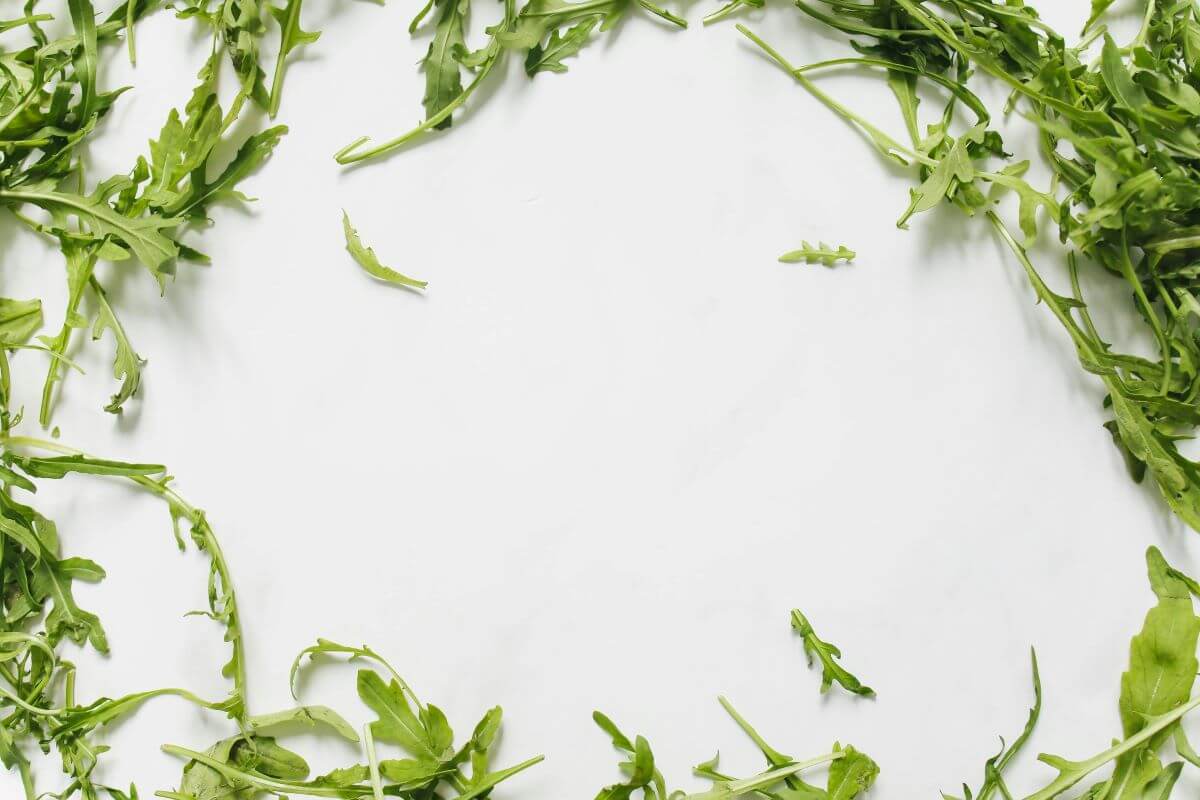
Frequently used in leafy salads, arugula (Eruca vesicaria, also known as Eruca sativa) is an annual plant crop from the Brassicaceae family. The arugula plant has Roman roots, and was cultivated as an herb for medicinal and aphrodisiac purposes. Today, arugula is sold in many grocery stores and farmers markets in the United States. Other common names for the arugula plant include colewort, garden rocket, roquette, ruchetta, rucola, and rucoli.
Growing arugula at home ensures your harvest is purely organic and gives you the chance to collect it early as microgreens. Arugula seeds can be sown in early spring in well-drained soil. If you’re aiming for a continuous, long-season harvest, sow your seeds every two weeks in the summer.
Common Arugula Types
Different arugula varieties have unique characteristics in their flavor, leaf shape, and size. Lesser-known varieties, like wild arugula, are available in farmers markets during early spring and fall.
Heirloom and Hybrid Arugulas
Arugula has heirloom and hybrid varieties.
Astro, Rocket, Runway, Slow Bolt, and Wild Arugula are a few of the heirloom varieties commonly sold in seed markets. These varieties are free from cross breeding for at least 40 to 50 years, having been passed down from generation to generation. Heirloom seeds are excellent for seed saving because you get similar traits of the parent plant.


Some gardeners associate heirloom varieties with issues in growth, and resistance to disease and pests. To alleviate these concerns, agriculturists produced hybrid cultivars through deliberate cross breeding of two varieties. This process allows them to make improvements on disease resistance, flavor, growth, pest resistance, size, yield, and other characteristics. Arugula (F1), Rocket or Roquette (F1), and Wild Rocket (F1) are some of the most popular arugula hybrids.
Other Popular Arugula Groupings
Learn more about the unique traits in these arugula varieties.
Types of Arugula Leaf Shapes
Arugula leaves can be categorized into two primary leaf shapes.
Types of Arugula Flavors
Most arugula varieties are peppery in taste, but other hints of flavor exist — depending on the variety.
Types of Arugula Lifecycles
Botanically, arugula is an annual crop, but some varieties are treated as perennials.
Types of Geographic Origins
The arugula plant is believed to have originated in the Mediterranean region, where it was cultivated by the Romans. It is prominent in Italian cuisine.
Types of Culinary Uses
Arugula leaves can be enjoyed fresh in salads, sandwiches, and wraps. They are cooked in some recipes. Many chefs use microgreen arugulas as garnish.
Types of Disease Resistance
Some arugula plants are more resistant to disease than others.
Types of Preferred Growing Conditions
Gardeners with a small space for planting should consider container arugulas that can be set on windowsills or porches. Another unconventional way of growing this leafy green is through a hydroponic system.
Popular Varieties of Serrated Arugulas


These varieties are characterized by serrated or jagged leaves.
| Variety | Description | Days to Germinate | Days to Maturity | Where to Buy |
|---|---|---|---|---|
| Common Arugula | The Common Arugula (Eruca sativa) variety is an excellent option for cool-season growing due to its quick maturity and reliable growth. The flavor is often compared to mustard, offering peppery pungency that works well in pizzas, salads, and sandwiches. | 5 to 7 days | 30 to 35 days | Territorial Seed Company, Rare Seeds |
| Bellezia | Bellezia boasts intermediate resistance to downy mildew and bolting. This serrated arugula maintains an upright growth, ensuring a clear harvest after maturity. You can collect them as baby greens or microgreens after 35 days. | 4 to 8 days | 35 to 50 days | Territorial Seed Company |
| Dragon’s Fire | Uniform in growth, this unique wild arugula variety displays eye-catching red veins across its serrated leaves. The Dragon’s Fire arugula has a tangy flavor that could work best (and add color) in leafy salads. | 4 to 8 days | 45 to 55 days | Territorial Seed Company |
| Runway | Runway arugula is suitable for container planting and microgreen cultivation. This heirloom variety grows deeply-lobed leaves with hints of zest in its flavor. | 5 to 14 days | 70 to 75 days | True Leaf Market |
| Slow Bolt | Considered one of the fastest growing arugula varieties, Slow Bolt can be cultivated in beds, pots, and even in indoor hydroponics. Unlike other arugulas, this wild type is slower to bolt and more tolerant to heat. Slow Bolt microgreens can be harvested after 25 days. | 5 to 7 days | 40 to 45 days | True Leaf Market |
| Speedy | Suitable for cultivation in late autumn, early spring, and winter, Speedy arugula offers mildly peppery leaves that can add crunch to your meals. | 4 to 8 days | 30 to 35 days | Territorial Seed Company |
| Uber | Uber’s quick growth and easy harvest makes it a great option for amateur home gardeners. You can enjoy Uber after 21 days from sowing as crunchy microgreens or have them at full maturity after 40 days. | 2 to 15 days | 21 to 40 days | Territorial Seed Company |
Popular Varieties of Broad Arugulas


Also referred to as the “regular arugula,” these varieties have large, broad leaves. They are deeply lobed and rounded.
| Variety | Description | Days to Germinate | Days to Maturity | Where to Buy |
|---|---|---|---|---|
| Astro | Astro arugula thrives well in areas with cool weather, and grows edible flowers. Expect a nutty flavor (that intensifies in warm weather) from these dark green leaves. After sowing, wait 8 to 12 days before harvesting the leaves as microgreens. | 5 to 14 days | 30 to 40 days | True Leaf Market |
| Balboa | Balboa is an early-maturing salad arugula that can resist bolting. Apart from in-ground growing, this arugula is suitable for hydroponic cultivation. Expect crunchy leaves that maintain an upright, uniform growth. | 8 to 10 days | 28 to 33 days | Territorial Seed Company |
| Green Brigade | Pungent and peppery, the semi-savoy leaves of Green Brigade can reach up to 5 and a half inches under ideal conditions. This variety produces uniformly shaped crops. If you ever run out of spinach leaves at home, Green Brigade is a great substitute. | 8 to 10 days | 28 to 33 days | Territorial Seed Company |
| Roquette | At best, the Roquette arugula variety grows broad leaves that are 12 to 18 inches tall. Roquette is an easy-to-grow variety and has resistance to frost. | 3 to 10 days | 30 to 40 days | Territorial Seed Company |
FAQ About Types of Arugulas
Which arugula varieties are great for microgreens?
Arugula microgreens can be enjoyed in countless ways. Whether added to salads and wraps, or as garnish to soups and stews, these easy-to-grow greens are packed with flavor and crunch. Among different varieties of arugula, Astro, Slow Bolt, and Runway are great choices for arugula microgreens.
Are arugulas and mizunas similar?
Arugulas and mizunas are often associated due to their similarities in appearance and kitchen use. These leafy greens can be used interchangeably in recipes, but mizunas is a type of mustard, not arugula.





